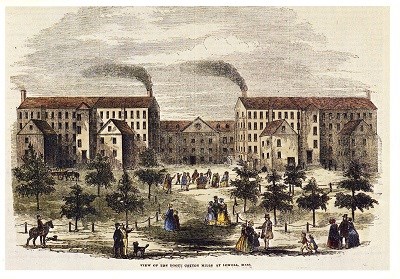
L. Stebbins, 1868; LNHP Library HC 105 .E5 1867 Vol.1 RES\ IntroductionWho were the “mill girls”? The term “mill girls” was occasionally used in antebellum newspapers and periodicals to describe the young Yankee women, generally 15 - 30 years old, who worked in the large cotton factories. They were also called “female operatives.” Female textile workers often described themselves as mill girls, while affirming the virtue of their class and the dignity of their labor. During early labor protests, they asserted that they were “the daughters of freemen” whose rights could not be “trampled upon with impunity.” Choices and Changes
To find workers for their mills in early Lowell, the textile corporations recruited women from New England farms and villages. These “daughters of Yankee farmers” had few economic opportunities, and many were enticed by the prospect of monthly cash wages and room and board in a comfortable boardinghouse. Beginning in 1823, with the opening of Lowell’s first factory, large numbers of young women moved to the growing city. In the mills, female workers faced long hours of toil and often grueling working conditions. Yet many female textile workers saved money and gained a measure of economic independence. In addition, the city’s shops and religious institutions, along with its educational and recreational activities, offered an exciting social life that most women from small villages had never experienced. Leaving Home
Baker Library, Harvard University On many farms the father was the property owner and head of household. Family members shared daily and seasonal tasks. In addition to strenuous chores outdoors, mothers and daughters toiled in the home, cooking, cleaning, and making clothes. This hardscrabble life proved increasingly difficult for young women, and by the early 1800s a growing number of Yankee farm families faced severe economic difficulties. For many young, rural women, the decision to leave home for a city like Lowell was often born of necessity. A New Way to Live and Work
For most young women, Lowell’s social and economic opportunities existed within the limits imposed by the powerful textile corporations. Most pronounced was the control corporations exerted over the lives of their workers. The men who ran the corporations and managed the mills sought to regulate the moral conduct and social behavior of their workforce. Within the factory, overseers were responsible for maintaining work discipline and meeting production schedules. In the boardinghouses, the keepers enforced curfews and strict codes of conduct. Male and female workers were expected to observe the Sabbath, and temperance was strongly encouraged. Life in a Boardinghouse
The majority of mill girls in Lowell lived in boardinghouses. These large, corporation-owned buildings were often run by a female keeper, or a husband and wife. A typical boardinghouse consisted of eight units, with 20 to 40 women living in each unit. Voices of Protest
Created by Winslow Homer, featured in Song of the Sower by William Cullen Bryant, 1871. Adding to the difficulties of organizing Lowell’s operatives was the changing ethnic composition of the workforce. The number of Irish employed in Lowell’s mills rose dramatically in the 1840s, as Irish men and women fled their faminestricken land. Thousands of immigrants from many other countries settled in Lowell in the decades after the Civil War, yet women remained a major part of the Lowell’s textile workforce. In large strikes against the textile manufacturers in 1903 and 1912, women workers played prominent roles. One Mill Girl's Story: Sarah Bagley
One of Lowell’s early leading labor reformers was a mill girl named Sarah Bagley. Born on a New Hampshire farm in 1806, Bagley arrived in Lowell in 1836 and worked in a number of mills. She became a powerful speaker on behalf of male and female workers, promoted the 10-hour workday, and edited the labor newspaper The Voice of Industry. In a letter to a friend in 1846, Bagley promoted the labor reform publication Factory Tracts as representing the interests of those “who are not willing to see our sex made into living machines to do the bidding of the incorporated aristocrats and reduced to a sum for their bodily services hardly sufficient to keep soul and body together.” Although the struggles of Bagley and other mill girls to achieve legislation for a 10-hour day failed, Lowell’s textile corporations did reduce the workday to 11 hours. |
Last updated: December 3, 2025
